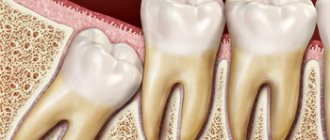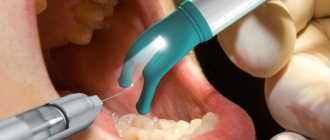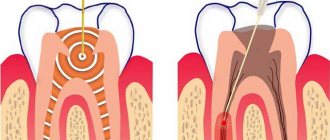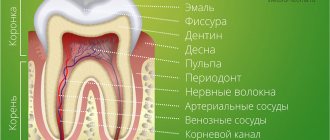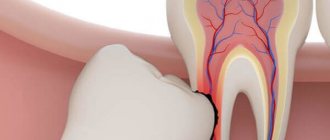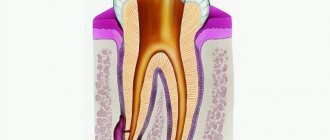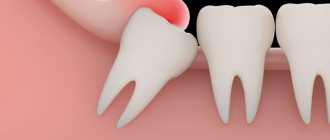For many people, rotten wisdom teeth pose a real and very serious threat to the health of the entire oral cavity - problematic third molars or, as they are also called, “eights” cause a lot of trouble for their owners. They erupt much later than the rest of the dentition (at about 20-25 years) and often become a problem already at the eruption stage.
What complications can wisdom teeth cause?
Difficulties arising from third molars are primarily associated with the late timing of their eruption and some anatomical features of the jaw structure:
- Lack of space for normal eruption. By the time the “eights” begin to cut, a person’s dentition is usually already fully formed, and there may simply not be enough space for the third molars. In addition, during evolution, the human jaw has decreased by about 1 cm, which also does not contribute to the normal growth of “eights”. In this case, tooth extraction is indicated to prevent displacement of the entire dentition.
- Incorrect position in a row (dystopia). Leads to soft tissue injuries, destruction and displacement of adjacent teeth.
- Incomplete eruption (retention). Impacted “eights” cause a lot of problems and discomfort - often such a wisdom tooth causes inflammation of the gums and diseases of the “neighbors” in the dentition.
- Pericoronitis. An inflammatory disease characterized by swelling of the gums near the wisdom tooth followed by suppuration. When teething is difficult, a so-called hood of mucous membrane is formed around the figure eight, which is the optimal place for the accumulation of food debris and the proliferation of bacteria. In this case, the wisdom tooth is cut and hurts due to inflammation of the hood. If nothing is done, gum inflammation develops not only next to the tooth, but throughout the entire jaw - this will require long-term and costly treatment of the gums.
- Deep caries of wisdom tooth. Third molars, as a rule, begin to deteriorate quickly, often at the eruption stage. Why do wisdom teeth crumble? This is due to both the peculiarities of its structure and its position: it is simply impossible to clean the “eights” well with paste and a brush, so food debris and bacteria necessarily accumulate there, creating favorable conditions for the development of infectious processes.
In all the described situations, it is better to remove wisdom teeth immediately, without waiting for serious complications to develop, and you will have to spend a lot of time and money on treating nearby teeth, as well as inflamed gums.
Pros and cons of removal tactics for caries of the lower or upper eights
Advantages of the extraction (removal) method:
- it is possible to completely eliminate the infectious focus, prevent the spread of the inflammatory process to adjacent teeth and nearby tissues;
- eliminates the risk of crowded teeth and the need for orthodontic correction;
- the risk of recurrent caries is eliminated;
- removal of the third molar allows you to radically solve the issue of pain in the area of this tooth.
The negative aspects of removing wisdom teeth include the risk of postoperative complications, as well as the inability to install a support for bridges or crowns on the figure eights, if necessary.
Can third molars be treated?
Wisdom teeth, like any other teeth, can be treated. But only if they erupt correctly, do not threaten the health and position of the rest of the dentition, and there is confidence that the treatment will be successful. If the specified conditions are met, it makes sense to preserve the “eight” for the following indications:
- If the sixth and seventh teeth are sick or severely damaged and must be removed, in this case the wisdom tooth is left as “the best of the worst” in order to provide the patient with at least some conditions for chewing, and the doctor - the basis for future prosthetics.
- If the six and seven have already been removed and it is necessary to preserve the abutment tooth for installation of prosthetic structures.
- In the presence of an antagonist tooth, completely healthy and subject to preservation.
In case of curved roots that complicate endodontic intervention, severe tissue destruction, dystopia or retention, no competent dentist will undertake to treat the “eights” - he will definitely recommend removal.
Stages of hole formation
The most common occurrence is the formation of a hole in a wisdom tooth. Inaccessible to cleaning with a regular brush, they become a convenient place for bacteria to accumulate. However, depressions in the enamel do not appear immediately; the last stages of caries development can be prevented if you constantly monitor the condition of your teeth. Let us briefly describe each of the progressive stages of caries development:
Initial stage: there is slight darkening on the tooth. To treat caries, it is enough to treat the affected area with a special solution, prescribe a diet, medicinal powders and toothpaste.
Superficial caries: there is slight destruction of the enamel without severe signs of pain. Slight roughness may be observed, and tooth sensitivity to cold and hot increases.
Middle stage: this is where the formation of depressions is diagnosed; not only the enamel is damaged, but also the dentin. Difficulties in brushing teeth and discomfort when eating sour, sweet or salty foods are noted. In this case, it is difficult to relieve pain even when taking analgesics.
Deep caries: the affected tooth cavity increases in size, the enamel is damaged over almost the entire area of the tooth, the dentin becomes softened. It is almost impossible to touch the tooth; there is complete damage to the neurovascular tissue.
Why are wisdom teeth needed?
Why does our body need third molars at all? In fact, these are rudiments that not all people today erupt - approximately a third of the entire population of the planet does not even have the rudiments of third molars, although a few thousand years ago absolutely all adults grew wisdom teeth. They practically do not perform the chewing function, since the rest of the healthy teeth usually cope with it.
Today, “eights” are needed only as a “backup option” in case the first and second molars fall out or are severely damaged, and also as a factor preventing the loosening of neighboring teeth. They can also serve as a support for prosthetics - but, again, in all these cases we are talking about healthy and correctly erupted “eights”. In the same case, when a person has rotten wisdom teeth in his mouth, they will not be able to perform any of the indicated functions and it is better to remove them so as not to expose the rest of the dentition to the risk of infection.
Painless wisdom tooth treatment at the Beryozka dental clinic
Wisdom teeth (or as doctors also call them - “eights”, third molars) often cause people a lot of trouble.
Moreover, according to medical expert statistics, it is they who are at risk of carious lesions more than any other area on the jaw. The causes of caries on the “eight” are no different from the causes of the disease in other teeth - poor heredity, neglect of hygiene and an excessive amount of carbohydrates in the daily diet. A specific factor that increases the risk of developing caries on the surface of a wisdom tooth is its location. Third molars that erupt in the gums, as a rule, not completely, are “embedded” in the jaw at an angle, which contributes to the accumulation of food debris in the tissue “hood.” It is difficult to clean the hidden corners of distant areas, and bacteria developing due to food debris contribute to active carious lesions of the “eight”.
Indications for removal
Healthy, well-positioned third molars with good oral access for possible treatment do not need to be extracted. There are clear indications for such an operation, and if they exist, it should be removed without waiting for complications:
- Deep caries of the wisdom tooth, as well as lack of normal access for full treatment.
- Chronic inflammatory processes caused by third molars, including in cases where the wisdom tooth caused inflammation of the gums.
- Chronic injuries to the oral mucosa due to incorrectly positioned “figure eight”.
- Impacted or dystopic teeth.
- The need for orthodontic treatment of bite defects if the doctor believes that the “eights” will prevent the dentition from occupying the correct position.
In all of these situations, it is recommended to remove the “eights” without delay.
Features of growth
Wisdom teeth are considered rudiments - organs that have lost their basic meaning. Previously, they were needed to chew tough foods. In the process of evolution, food became softer and softer, so the need for them gradually disappeared. Over time, the size of the jaw has also changed - it has become smaller, and now cannot accommodate four extra teeth.
Typically, wisdom teeth appear between the ages of 18 and 27. It has been proven that “eights” do not affect the chewing process in any way - a person can easily do without them. Some people don't have them at all, and that's normal.
Removal Features
As a rule, operations to remove third molars are always considered difficult, since these are the teeth that usually cause more problems. The operation can be simple, provided that the “figure eight” is located on the upper jaw and does not have pronounced developmental abnormalities. In all other cases (as well as in situations where the tooth is in the upper jaw, but has strong, curved and branched roots), the operation is considered complex and must be performed by a qualified dental surgeon.
Before performing an intervention, the doctor determines possible contraindications for a particular patient, examines an x-ray of the problem area and determines the optimal tactics for the operation. The duration of the procedure ranges from 1-10 minutes for simple removal and up to 20-120 minutes for complex removal, requiring a series of manipulations and suturing of the hole.
Is prophylactic removal justified?
There are organs in the human body whose functions have been lost as a result of evolution. For example, this is considered the appendix (although scientists have not yet clarified its purpose), ear muscles and coccyx (former caudal vertebrae). Wisdom teeth are the same rudimentary organ. Previously, they were used to chew hard food. After humanity switched to soft food prepared in kitchens, they became unnecessary.
Many owners of “lucky” teeth are ready to remove them immediately after eruption, especially if it was problematic. Anatomically, vital nerves, lymph nodes, and blood vessels are located next to these teeth. Inflammation in this place can quickly go deeper and become dangerous not only to health, but also to life. Therefore, some surgeons adhere to the theory of prophylactic removal. If the patient is not ready to run to a specialist at the first pain or cannot do this due to the remoteness of the clinic, then it makes sense to remove these teeth.
Sometimes “eights” are removed for cosmetic reasons, when all the teeth cannot fit on a narrow jaw and the dentition begins to bend. In this case, the decision must be conscious and thoughtful. If the patient's teeth are all in good condition, and aesthetics are really important, then sometimes it really makes sense to sacrifice something. But it is often possible to do without this.
Removal of wisdom teeth under general anesthesia
Many patients are afraid to remove problematic “eights” because they fear that the process will be painful. However, you should not postpone the operation because of your own fear: modern methods of anesthesia allow the removal to be performed as painlessly and comfortably as possible for the patient.
Doctors usually recommend performing the intervention under local anesthesia, which will be sufficient to ensure the patient is comfortable during the operation. If for some reason a person is not satisfied with the methods of local anesthesia, there is always the possibility of having a wisdom tooth removed under anesthesia. It should be remembered that this option of pain relief is not available to everyone - there are certain contraindications:
- Decompensated diabetes mellitus and cardiovascular diseases.
- Post-infarction or post-stroke periods for up to 6 months.
- Acute inflammatory diseases of internal organs, including the respiratory system.
- Epilepsy.
- Severe thyroid disease.
- Bronchial asthma.
- Alcohol or drug intoxication.
The presence of at least one of the listed positions makes the removal of wisdom teeth under general anesthesia impossible. Before the operation, the patient must be examined to identify any contraindications to the use of anesthesia. In addition, you need to remember that certain preoperative preparation will be required, and the clinic itself, in which the wisdom tooth will be removed under anesthesia, must have all the necessary equipment, as well as a team of specialists who will treat and monitor the patient’s condition (anesthesiologists, resuscitators, trained nursing staff).
Removal steps
The procedure can be divided into three stages:
- preparatory;
- The operation itself;
- After surgery.
Preparatory stage.
At this stage, the doctor visually examines the patient's oral cavity. Then a computed tomography is done to look at the length and shape of the roots, the depth of the tooth, etc.
Surgery
Complex wisdom tooth removal is divided into several stages. Let's consider a generalized operation scheme:
- A painkiller is given. To do this, a needle is inserted into the lower jaw to the nerve bundle so that the patient does not feel pain. Lips, chin, tongue are numbed. If sensitivity does not disappear, an additional injection is given. After anesthesia, the course of a complex extraction procedure depends on the location of the tooth.
- An incision is made with a scalpel.
- The tooth is sawed down to make it easier to remove.
- Take out the crown and roots.
- The wound is treated and sutured.
This completes the surgical stage.
Postoperative stage
This stage is very important, its duration is 7 – 10 days. During this period, the surgical wound heals, and a clot first forms in the hole and then resolves. Patients must follow our doctor's instructions exactly to avoid post-operative complications.
Tooth extraction: how long does the procedure take?
With a simple type of extraction, the procedure is carried out in 10 - 20 minutes. The process of complex removal lasts from 30 minutes or longer, depending on the specifics of the operation. For example, removing a horizontal tooth can take up to 2 hours or more. At the same time, sometimes additional preparatory procedures are necessary, which also take time.
After tooth extraction in the lower jaw antibiotics to prevent the entry and spread of infection. Such complex manipulations are contraindicated for pregnant and nursing mothers. Painkillers are prescribed to reduce pain after the procedure.
For complex removal, the patient is asked to come back again in five days or earlier if a fever appears. If the tooth has come out halfway (semi-retinated tooth), removal is carried out in the same way, but it is easier to pull it out, since part of the molar is on the surface.
Treatment or removal during pregnancy
In cases where a wisdom tooth is cut and hurts, causing constant discomfort to the pregnant woman, it can and should be treated regardless of the gestational age. If there is no acute pain and treatment can be postponed, then it is advisable to carry it out in the second trimester of pregnancy or after childbirth.
It is worth remembering that wisdom tooth removal, especially under anesthesia, is definitely contraindicated for pregnant women. Removing third molars is strongly not recommended due to the complexity of such an operation and the risk of developing postoperative complications. As for anesthesia, it cannot be used either for removal or for treatment - during pregnancy, only local anesthesia can be used, and the drugs should be selected very carefully and taking into account the patient’s condition.
Despite their name, wisdom teeth do not bring their owners increased intellectual abilities, but they can cause a number of very unpleasant problems with oral health. Typically, third molars “lead with them” swelling of the gums, purulent inflammation, the development of caries of neighboring teeth, as well as severe pain. Therefore, in modern dentistry they prefer to remove them, without waiting for serious complications to arise and longer and more expensive treatment to be required. In many European countries today, a common practice is to remove the “eights” immediately after their appearance, regardless of their condition and the correctness of eruption.
Speculation and truth about preserving wisdom teeth
Speculation No. 1. Some people believe that nature has nothing superfluous, which means that third molars are useful for something. But it has already been scientifically proven that our chewing system can cope quite well without these teeth. Now the norm for a person is 28 teeth, not 32.
Speculation No. 2. Sometimes they want to preserve wisdom teeth at all costs in order to use the “eight” in a bridge structure in the future if one of the chewing teeth fails or collapses. But this is a misconception. Firstly, because the “eights”, as a rule, occupy the wrong place, which makes it impossible to install a bridge. Secondly, modern dentistry is trying to get away as much as possible from bridge-like or combined structures in favor of single ones. Today, implantation is the highest quality and modern method of replacing missing teeth.
It is fair to note that a number of scientific and practical works are being carried out in the world, as well as in our clinic, related to the transplantation of eighth teeth in place of lost, damaged sixth or seventh teeth. But at present, such operations are exclusively scientific and research in nature. This technique has maximum observation results of less than 10 years - for dentistry this is still the minimum period of time to be able to talk about some kind of statistics or system. In addition, transplanting such teeth has a lot of restrictions: only an erupted tooth is transplanted, healthy in all respects, without caries, the bone tissue at the transplant site should not be damaged, and so on... This is far from a mass procedure, which is performed only by leading surgeons, very a small number of patients. If you wish to use a wisdom tooth for transplantation, a patient at our clinic must undergo a specialized consultation, following which a council of specialists will decide on the possibility of this type of treatment.
World dentistry has clearly formulated its attitude towards preserving wisdom teeth - they can be preserved only under the following conditions:
— there is enough space on the jaw for their teething;
— having erupted, these teeth did not disturb a person’s bite;
— there are normal conditions for maintaining good hygiene of these teeth.
If a carious process has begun on these teeth, or they in any way interfere with other teeth or the chewing process in general, then this is an absolute indication for their removal. The only reasonable and correct way to treat wisdom teeth is to remove them. World dentistry in this matter is merciless to the “eights” and allows their presence exactly until the moment they do not harm anything. It is difficult to independently assess the destructive ability of third molars, since a person is very adaptive. Only a specialist can identify the disturbances that wisdom teeth introduce into the functioning of the dental system.
Speculation No. 3. Sometimes people think that if wisdom teeth have not erupted, then there is absolutely no need to worry about them. However, unerupted teeth are a kind of cocked spring that is located inside a person’s jaw, and if any unfavorable factor begins to act on this spring, it will make itself felt. Hidden “eights” can provoke all kinds of inflammation of the gums, cause caries, and cause pain. Of course, not all wisdom teeth that remain undetected are dangerous, but in any case they need to be monitored. A person who has not acquired wisdom teeth (one, two, three or all four) often cannot independently understand whether he has them, or whether he is lucky - and they are not even in the rudiments. To determine this, you need to undergo an X-ray examination, at least take a general panoramic image (OPTG), or undergo a modern cone-beam computed tomography (CBCT). Ideally, such images should be taken for diagnostic purposes once every 2-3 years for each person in order to exclude hidden processes and assess the general condition of the jaw. Modern X-ray examinations have ultra-low radiation, so such examinations are as safe as possible.
The eighth teeth are removed if necessary, starting at the age of 12-14 years. This is usually associated with orthodontic treatment. Before orthodontic treatment at any age, two things are mandatory: thorough oral hygiene and removal of wisdom teeth, erupted or unerupted.
